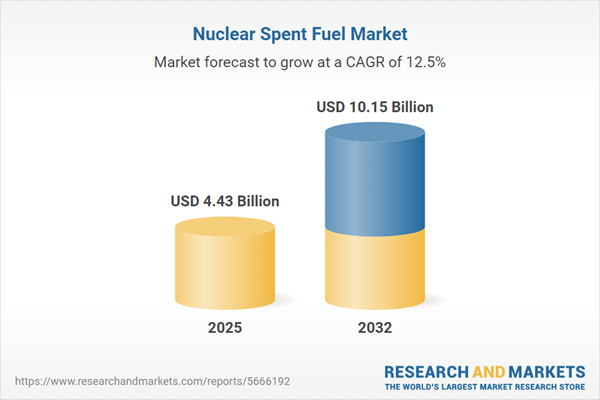Speak directly to the analyst to clarify any post sales queries you may have.
The nuclear spent fuel market is in a period of accelerated change, prompting leaders to pivot strategies as regulations, technologies, and operational pressures evolve. Senior decision-makers now face heightened imperatives to optimize resources, enforce compliance, and refine risk frameworks to ensure performance and continuity in this specialized domain.
Market Snapshot: Nuclear Spent Fuel Market Growth and Dynamics
The nuclear spent fuel market continues its robust trajectory, marked by a compound annual growth rate (CAGR) of 12.54%. This growth results from coordinated industry moves in response to widespread reactor retirements and an industry-wide shift toward advanced fuel management solutions. Stakeholders are dedicating resources to modernizing fuel handling protocols and increasing investment in safety systems. The sector is responding to regulatory adaptation by upgrading storage, conditioning, and transportation infrastructure, with organizations selectively customizing compliance strategies. As flexible operating models become prevalent, businesses are capitalizing on opportunities within both established and emerging regional markets, adjusting to changing regulatory and operational landscapes to sustain momentum.
Scope & Segmentation: Nuclear Spent Fuel Market
Understanding segmentation in the nuclear spent fuel sector is integral for organizations evaluating procurement strategies, technology investments, and geopolitical risks. Each segment is shaped by specialized requirements and drives tailored approaches throughout the market.
- Service Type: Covers fuel conditioning, safe disposal, reprocessing activities, interim and extended storage, compaction, encapsulation, geological storage, and multimodal transport—each entailing rigorous logistics and compliance oversight.
- Fuel Type: Encompasses metal fuels, uranium oxide, and mixed oxide (MOX) fuel. Each fuel category dictates unique safety protocols, operational demands, and lifecycle management priorities, making strategic choices in this area integral for risk mitigation.
- Packaging Type: Includes canisters, transport casks, and shielding containers, emphasizing the need for secure containment, regulatory alignment, and efficient logistics during storage and transport operations.
- End User: Encompasses defense agencies, commercial nuclear operators, and research institutions, each shaping procurement and compliance strategies in accordance with distinct operational criteria.
- Regional Coverage: Spans the Americas, Europe, Asia-Pacific, Middle East, and Africa, highlighting leading geographies like the United States, China, Germany, India, and South Africa, where local policy and market contexts require nuanced approaches.
- Key Company Analysis: Reviews the strategies of organizations including Orano SA, Framatome SA, Rosatom, Westinghouse Electric Company LLC, Holtec International Inc., EnergySolutions, Jacobs Engineering Group Inc., BWX Technologies, Babcock International Group PLC, and China National Nuclear Corporation—offering insight into sector leadership, innovation, and collaborative potential.
Nuclear Spent Fuel Market: Strategic Key Takeaways
- Building out advanced waste handling and operational management capabilities strengthens adaptability to shifting regulatory requirements, embedding compliance into core operations.
- Integration of digital oversight and monitoring platforms improves transparency and governance for sensitive facility processes, promoting seamless audit readiness across enterprise functions.
- Ongoing innovation in recycling and disposal techniques supports strategic resource allocation, ensuring organizations keep pace with dynamic global risk expectations.
- Deployment of automated, multimodal logistics systems streamlines spent fuel transfer, supporting security and reliability across increasingly complex operating environments.
- Developing customized solutions tailored by end-user segment remains crucial for maintaining supplier relationships and sustaining differentiation in a regulated marketplace.
Tariff Impact: United States, 2025
The advent of new tariffs on nuclear spent fuel equipment and systems in the United States is altering procurement strategies and placing additional pressure on established supply chains. In response, organizations are shifting to domestic sourcing, investing in expanding local production capabilities, and diversifying supplier portfolios. These measures are influencing project timelines and contract structures, driving a renewed focus on supply chain resilience as regulatory and commercial variables evolve.
Methodology & Data Sources
This analysis is built on comprehensive secondary research, drawing from technical and regulatory documentation, as well as the latest relevant white papers. Input from compliance and engineering executives in the utility sector ensures that findings reflect sector realities and offer direct, tactical value for planning and decision-making.
Why This Report Matters for Senior Decision-Makers
- Delivers targeted, actionable guidance for interpreting shifts in both regulation and technology across the nuclear spent fuel market, enhancing operational and investment readiness.
- Supports more effective procurement and enterprise risk management, enabling decision-makers to proactively adapt to evolving compliance requirements and shifting regional priorities.
- Offers granular analysis essential for optimizing resource deployment, forming strategic partnerships, and refining tactics in a complex, highly regulated market landscape.
Conclusion: Strategic Path Forward
Armed with current intelligence and adaptive strategic direction, decision-makers are well-positioned to reinforce compliance, improve operational outcomes, and navigate future developments in the nuclear spent fuel sector confidently.
Additional Product Information:
- Purchase of this report includes 1 year online access with quarterly updates.
- This report can be updated on request. Please contact our Customer Experience team using the Ask a Question widget on our website.
Table of Contents
3. Executive Summary
4. Market Overview
7. Cumulative Impact of Artificial Intelligence 2025
Companies Mentioned
The companies profiled in this Nuclear Spent Fuel market report include:- Orano SA
- Rosatom State Nuclear Energy Corporation
- Framatome SA
- Westinghouse Electric Company LLC
- Holtec International Inc.
- EnergySolutions, Inc.
- Jacobs Engineering Group Inc.
- BWX Technologies, Inc.
- China National Nuclear Corporation
- Babcock International Group PLC
Table Information
| Report Attribute | Details |
|---|---|
| No. of Pages | 191 |
| Published | October 2025 |
| Forecast Period | 2025 - 2032 |
| Estimated Market Value ( USD | $ 4.43 Billion |
| Forecasted Market Value ( USD | $ 10.15 Billion |
| Compound Annual Growth Rate | 12.5% |
| Regions Covered | Global |
| No. of Companies Mentioned | 11 |









